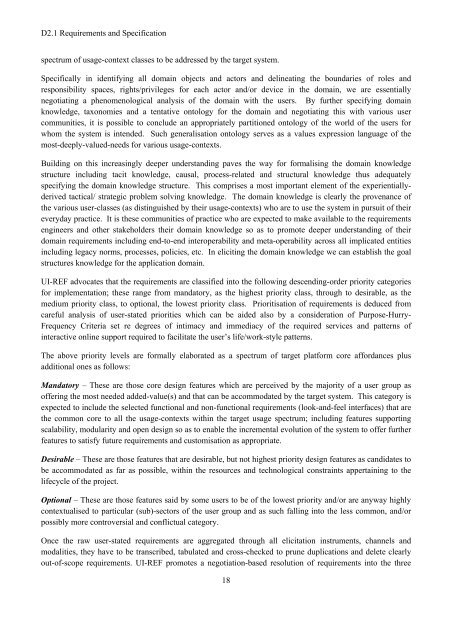D2.1 Requirements and Specification - CORBYS
D2.1 Requirements and Specification - CORBYS
D2.1 Requirements and Specification - CORBYS
Create successful ePaper yourself
Turn your PDF publications into a flip-book with our unique Google optimized e-Paper software.
<strong>D2.1</strong> <strong>Requirements</strong> <strong>and</strong> <strong>Specification</strong><br />
spectrum of usage-context classes to be addressed by the target system.<br />
Specifically in identifying all domain objects <strong>and</strong> actors <strong>and</strong> delineating the boundaries of roles <strong>and</strong><br />
responsibility spaces, rights/privileges for each actor <strong>and</strong>/or device in the domain, we are essentially<br />
negotiating a phenomenological analysis of the domain with the users. By further specifying domain<br />
knowledge, taxonomies <strong>and</strong> a tentative ontology for the domain <strong>and</strong> negotiating this with various user<br />
communities, it is possible to conclude an appropriately partitioned ontology of the world of the users for<br />
whom the system is intended. Such generalisation ontology serves as a values expression language of the<br />
most-deeply-valued-needs for various usage-contexts.<br />
Building on this increasingly deeper underst<strong>and</strong>ing paves the way for formalising the domain knowledge<br />
structure including tacit knowledge, causal, process-related <strong>and</strong> structural knowledge thus adequately<br />
specifying the domain knowledge structure. This comprises a most important element of the experientiallyderived<br />
tactical/ strategic problem solving knowledge. The domain knowledge is clearly the provenance of<br />
the various user-classes (as distinguished by their usage-contexts) who are to use the system in pursuit of their<br />
everyday practice. It is these communities of practice who are expected to make available to the requirements<br />
engineers <strong>and</strong> other stakeholders their domain knowledge so as to promote deeper underst<strong>and</strong>ing of their<br />
domain requirements including end-to-end interoperability <strong>and</strong> meta-operability across all implicated entities<br />
including legacy norms, processes, policies, etc. In eliciting the domain knowledge we can establish the goal<br />
structures knowledge for the application domain.<br />
UI-REF advocates that the requirements are classified into the following descending-order priority categories<br />
for implementation; these range from m<strong>and</strong>atory, as the highest priority class, through to desirable, as the<br />
medium priority class, to optional, the lowest priority class. Prioritisation of requirements is deduced from<br />
careful analysis of user-stated priorities which can be aided also by a consideration of Purpose-Hurry-<br />
Frequency Criteria set re degrees of intimacy <strong>and</strong> immediacy of the required services <strong>and</strong> patterns of<br />
interactive online support required to facilitate the user’s life/work-style patterns.<br />
The above priority levels are formally elaborated as a spectrum of target platform core affordances plus<br />
additional ones as follows:<br />
M<strong>and</strong>atory – These are those core design features which are perceived by the majority of a user group as<br />
offering the most needed added-value(s) <strong>and</strong> that can be accommodated by the target system. This category is<br />
expected to include the selected functional <strong>and</strong> non-functional requirements (look-<strong>and</strong>-feel interfaces) that are<br />
the common core to all the usage-contexts within the target usage spectrum; including features supporting<br />
scalability, modularity <strong>and</strong> open design so as to enable the incremental evolution of the system to offer further<br />
features to satisfy future requirements <strong>and</strong> customisation as appropriate.<br />
Desirable – These are those features that are desirable, but not highest priority design features as c<strong>and</strong>idates to<br />
be accommodated as far as possible, within the resources <strong>and</strong> technological constraints appertaining to the<br />
lifecycle of the project.<br />
Optional – These are those features said by some users to be of the lowest priority <strong>and</strong>/or are anyway highly<br />
contextualised to particular (sub)-sectors of the user group <strong>and</strong> as such falling into the less common, <strong>and</strong>/or<br />
possibly more controversial <strong>and</strong> conflictual category.<br />
Once the raw user-stated requirements are aggregated through all elicitation instruments, channels <strong>and</strong><br />
modalities, they have to be transcribed, tabulated <strong>and</strong> cross-checked to prune duplications <strong>and</strong> delete clearly<br />
out-of-scope requirements. UI-REF promotes a negotiation-based resolution of requirements into the three<br />
18


